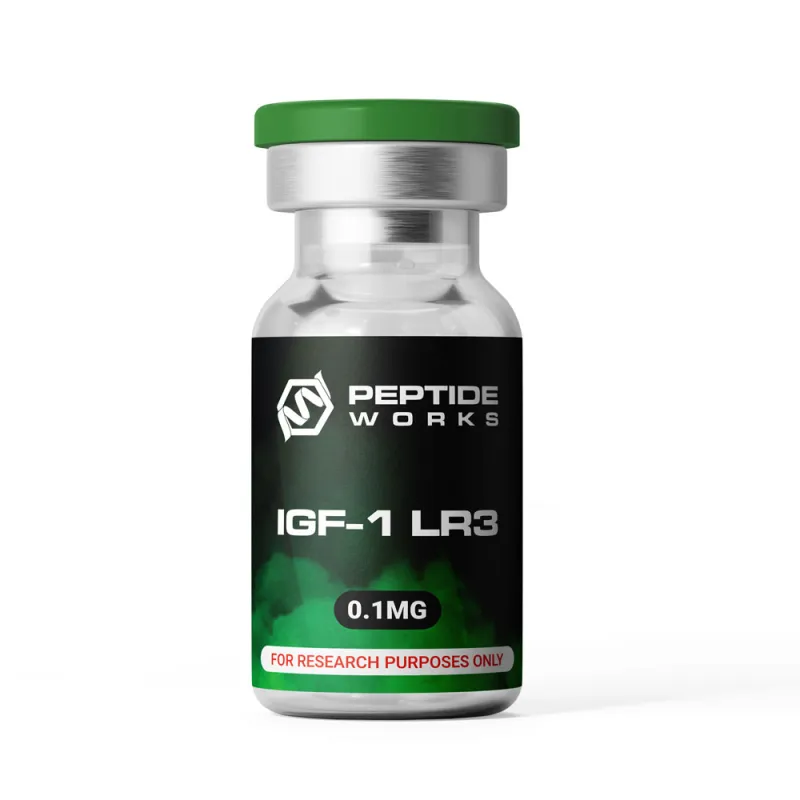
PROMO!
First order? Get 10% OFF with this code: 1storder
Written by

Research studies show IGF-1 LR3 demonstrates promising results for muscle recovery applications. This synthetic peptide, composed of short chains of amino acids, exhibits enhanced protein synthesis capabilities in laboratory settings.
Scientific data indicates improved satellite cell activation compared to natural IGF-1 variants. Recovery peptide research reveals IGF-1 LR3’s extended activity duration in controlled studies, which contributes to maintaining muscle mass and improved body composition outcomes.
Multiple investigations examine its potential alongside other specific peptides like BPC-157 and TB500 for tissue repair. These recovery peptides show different mechanisms for muscle healing research. Peptide Works sells research peptides for scientific investigation. These are for research purposes only, not for human use.
The effectiveness of IGF-1 LR3 as a recovery peptide becomes clear when examining how it enhances protein synthesis at the cellular level. This peptide plays a crucial role in accelerating the healing process and supporting the body’s natural healing processes for muscle injuries.
Explore IGF-1 LR3 from Peptide Works, a peptide that boosts muscle protein synthesis and accelerates quicker recovery for enhanced strength.

IGF-1 LR3 activates protein synthesis through mTOR pathway signaling in muscle cells. This recovery peptide binds to IGF-1 receptors and triggers anabolic cascades. Research shows enhanced amino acid uptake into muscle tissue occurs within hours. The peptide bypasses binding proteins that limit natural IGF-1 effectiveness.
Studies demonstrate increased ribosome recruitment for new protein formation. Unlike BPC-157’s angiogenesis or TB500’s cell migration mechanisms, IGF-1 LR3 directly stimulates muscle protein production. This extended activity duration supports continuous recovery processes and, helps reduce muscle atrophy during periods of limited activity.
This protein synthesis process operates through a central control system that determines when muscles build or break down, emphasizing IGF-1 LR3’s key role in maintaining healthy cellular regeneration, and supporting collagen production for faster healing.
Discover BPC-157 from Peptide Works, a peptide that promotes tendon, ligament, and tissue repair for faster injury recovery.
mTOR acts as the master control switch for muscle building and recovery processes. This cellular pathway decides when muscles grow or break down based on available nutrients and signals. Recovery peptides like IGF-1 LR3 directly activate mTOR to boost protein creation. The pathway turns on ribosome production and amino acid uptake for muscle repair. mTOR also controls autophagy, which cleans damaged proteins from muscle cells.
BPC-157 and TB500 work through different pathways but still influence mTOR activity indirectly. When mTOR gets activated, muscles switch from breakdown mode to building mode. This makes mTOR the key target for effective recovery peptide action.
Understanding how mTOR controls these processes leads to an important question about timing how quickly do these effects actually occur?

Recovery peptides show effects at different speeds based on their half-life and mechanisms. IGF-1 LR3 demonstrates the fastest muscle building response due to its extended twenty to thirty hour half-life. Users typically notice enhanced protein synthesis within days to weeks of starting treatment.
BPC-157 and TB500 work differently for tissue repair, with effects appearing within seven to fourteen days. The recovery peptide timeline depends on individual response and dosing protocols. IGF-1 LR3 creates sustained anabolic effects through continuous mTOR activation. Most peptides show initial effects within weeks, with continued benefits developing over months.
The speed at which these peptides work relates directly to their tissue repair mechanisms, which involve multiple biological processes.
Checkout TB500 from Peptide Works, a peptide that supports cell migration and reduces inflammation for comprehensive tissue healing.
Recovery peptides support tissue repair through three main biological processes that fix damaged cells and tissues. BPC-157 stimulates collagen synthesis and promotes the formation of new blood vessels, a process called angiogenesis. This recovery peptide also enhances fibroblast proliferation to rebuild connective tissues like tendons and ligaments, supporting joint health and flexibility.
TB500 works differently by promoting cell migration to injury sites and reducing harmful inflammation. IGF-1 LR3 supports tissue repair through enhanced protein production that rebuilds damaged muscle fibers. These peptides also increase blood flow to deliver oxygen and nutrients needed for healing and act as a protective compound that may help reduce joint pain during the wound healing process. Together, they create optimal conditions for faster tissue regeneration and reduced recovery time.
While these recovery benefits are well-documented, researchers should also understand the potential side effects before implementing these compounds.

Recovery peptides generally cause mild side effects that resolve quickly with proper dosing. Injection site reactions like redness and swelling are the most common issues across all recovery peptides. IGF-1 LR3 may cause low blood sugar, water retention, and joint stiffness due to its extended half-life.
BPC-157 users report mild headaches, nausea, and temporary dizziness in the first few days. TB500 typically causes fatigue, lightheadedness, and injection site irritation that fades within hours. Most side effects are dose-dependent and improve with conservative dosing protocols. Allergic reactions remain rare but require immediate medical attention if they occur.
Having established both the benefits and safety profile, researchers need practical guidance for choosing the right peptide for their specific applications.
Each recovery peptide targets different aspects of muscle and tissue repair through unique mechanisms. IGF-1 LR3 excels at muscle building through direct protein synthesis and mTOR activation with its extended thirty-hour half-life. BPC-157 specializes in injury recovery by promoting collagen synthesis and new blood vessel formation for faster tissue repair.
TB500 works best for systemic healing through enhanced cell migration and inflammation reduction across multiple tissue types. Choose IGF-1 LR3 for muscle growth, BPC-157 for localized injuries, or TB500 for full-body recovery applications.
| Recovery Peptide | Primary Function | Best For | Timeline |
|---|---|---|---|
| IGF-1 LR3 | Muscle protein synthesis | Muscle building & strength | Days to weeks |
| BPC-157 | Tissue healing & collagen | Injury recovery & tendons | 7-14 days |
| TB500 | Cell migration & inflammation | Systemic tissue repair | 1-4 weeks |
As research in this field continues to expand, the future holds even greater potential for recovery peptide applications.
IGF-1 LR3 is a strong muscle recovery peptide that boosts protein building through cellular pathways. Comparing IGF-1 LR3, BPC-157, and TB500 shows how each peptide works differently for recovery needs. These compounds work in different ways – from building muscle to fixing tissue and reducing swelling.
Current studies show good results with mild side effects when used right. The future of muscle recovery peptides looks bright as scientists keep making better compounds with safer profiles.
Better delivery methods and mixing peptides may soon give faster recovery times and better results for researchers studying muscle repair and tissue healing. Peptide Works provides research-grade compounds for scientific investigation into these promising recovery applications.
All products discussed are supplied for research purposes only and are not intended for human use.
[1] Philippou A, Barton ER. Optimizing IGF-I for skeletal muscle therapeutics. Growth Horm IGF Res. 2014 Oct;24(5):157-63.
[2] Song YH, Song JL, Delafontaine P, Godard MP. The therapeutic potential of IGF-I in skeletal muscle repair. Trends Endocrinol Metab. 2013 Jun;24(6):310-9.
[3] Pevec D, Novinscak T, Brcic L, Sipos K, et al. Impact of pentadecapeptide BPC 157 on muscle healing impaired by systemic corticosteroid application. Med Sci Monit. 2010 Mar;16(3):BR81-88.
[4] Vasireddi N, Hahamyan H, Salata MJ, Karns M, et al. Emerging Use of BPC-157 in Orthopaedic Sports Medicine: A Systematic Review. HSS J. 2025 Jul 31:15563316251355551.
[5] Spurney CF, Cha HJ, Sali A, Pandey GS, et al. Evaluation of skeletal and cardiac muscle function after chronic administration of thymosin beta-4 in the dystrophin deficient mouse. PLoS One. 2010 Jan 29;5(1):e8976.
ALL CONTENT AND PRODUCT INFORMATION AVAILABLE ON THIS WEBSITE IS FOR EDUCATIONAL PURPOSES ONLY.
DISCLAIMER: These products are intended solely as a research chemical only. This classification allows for their use only for research development and laboratory studies. The information available on our Peptide Works website: https://peptide-works.com/ is provided for educational purposes only. These products are not for human or animal use or consumption in any manner. Handling of these products should be limited to suitably qualified professionals. They are not to be classified as a drug, food, cosmetic, or medicinal product and must not be mislabelled or used as such.
Peptide Works
Related Articles

Best Peptides for Women in Perimenopause: From Libido to Energy
Do you feel drained, struggle with focus, or notice your drive slipping during perimenopause? These changes are some of the

PT-141 for Women in Perimenopause: A Breakthrough for Low Libido
Perimenopause can bring more than just physical changes it often affects how women feel about intimacy, confidence, and connection. Many

Can Vitamin B12 Immune System Support Enhance the Effects of Thymosin Alpha-1?
The Vitamin B12 immune system link is important because this vitamin plays a crucial role in DNA synthesis, methylation, energy